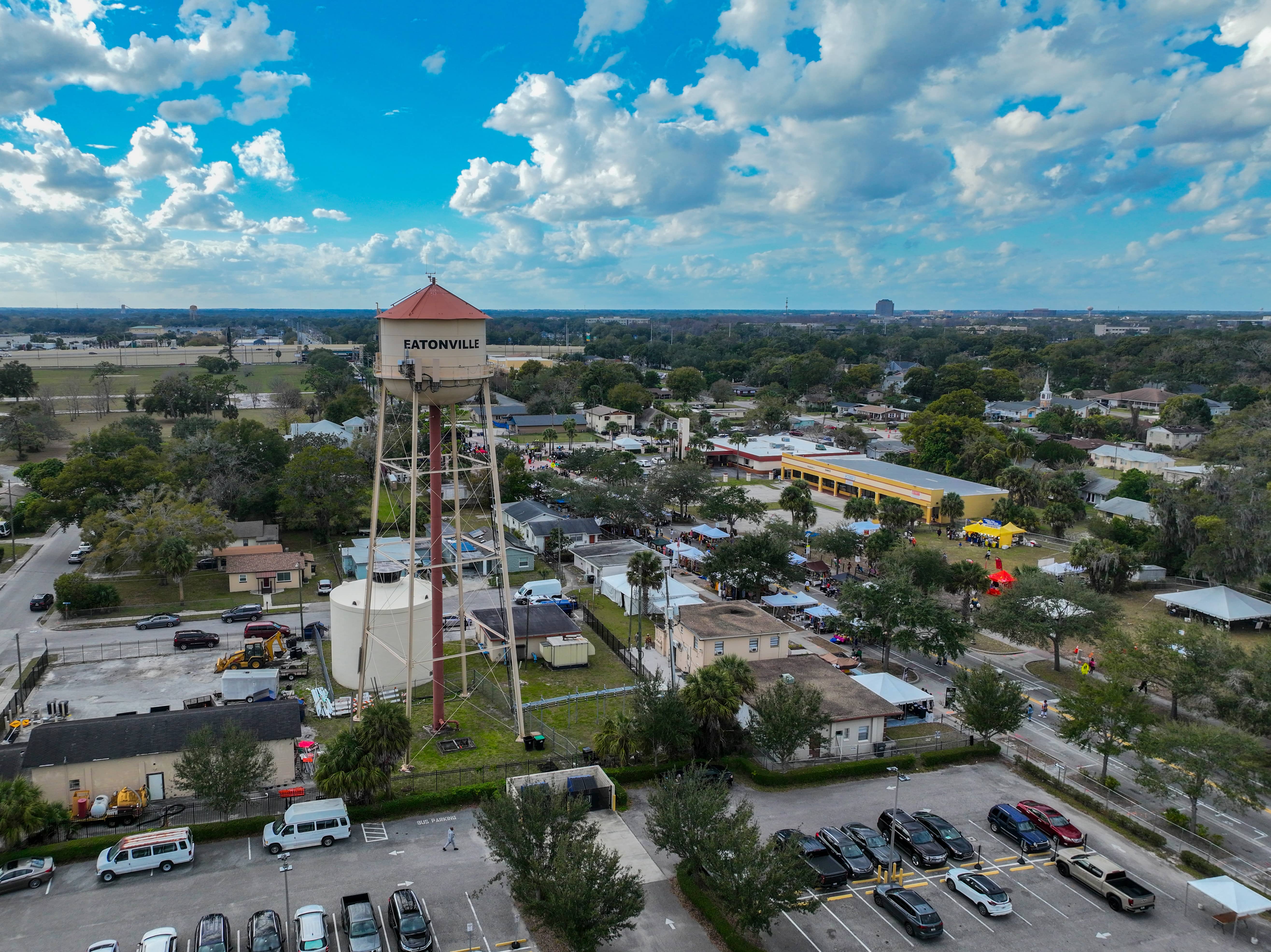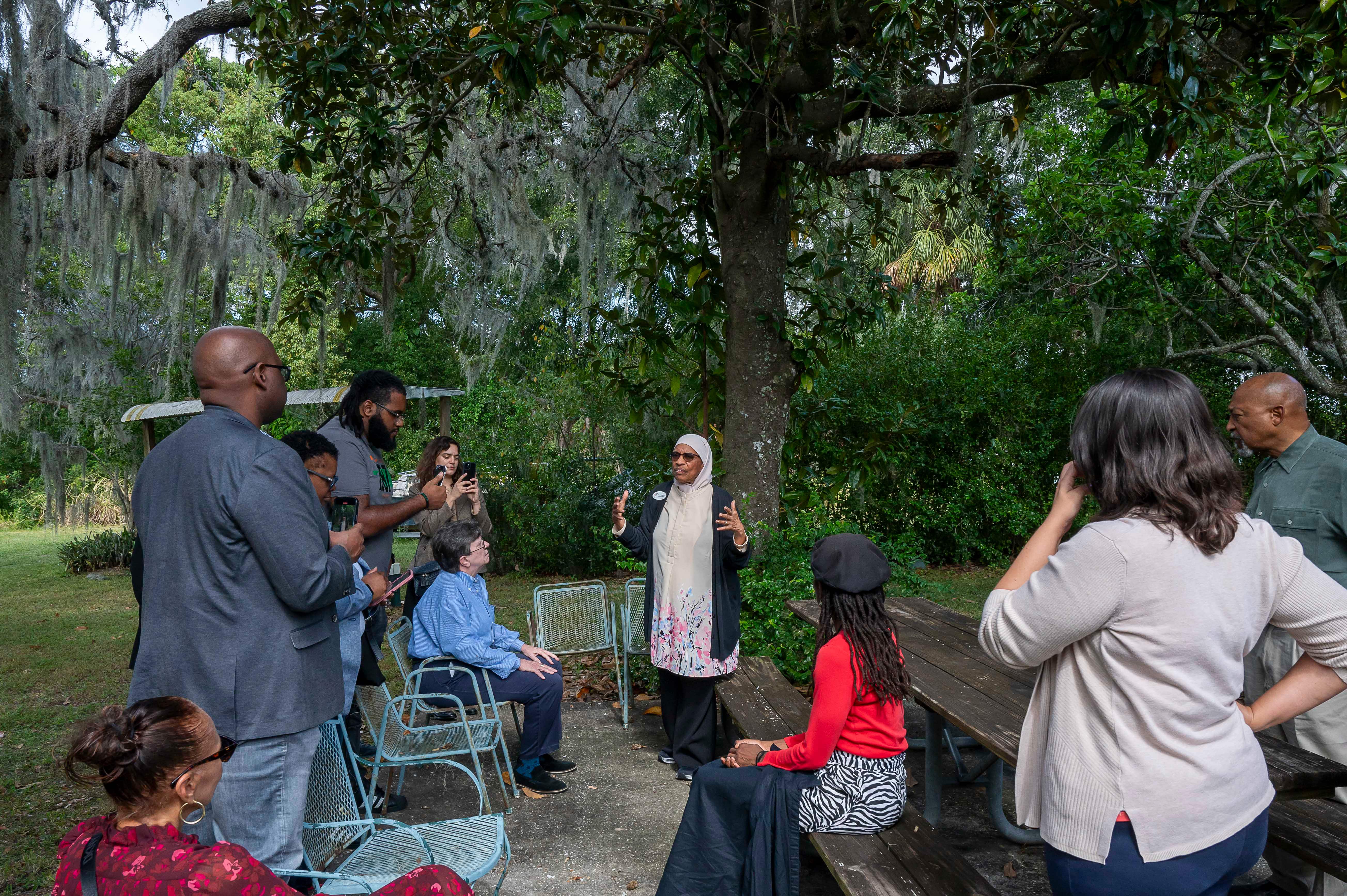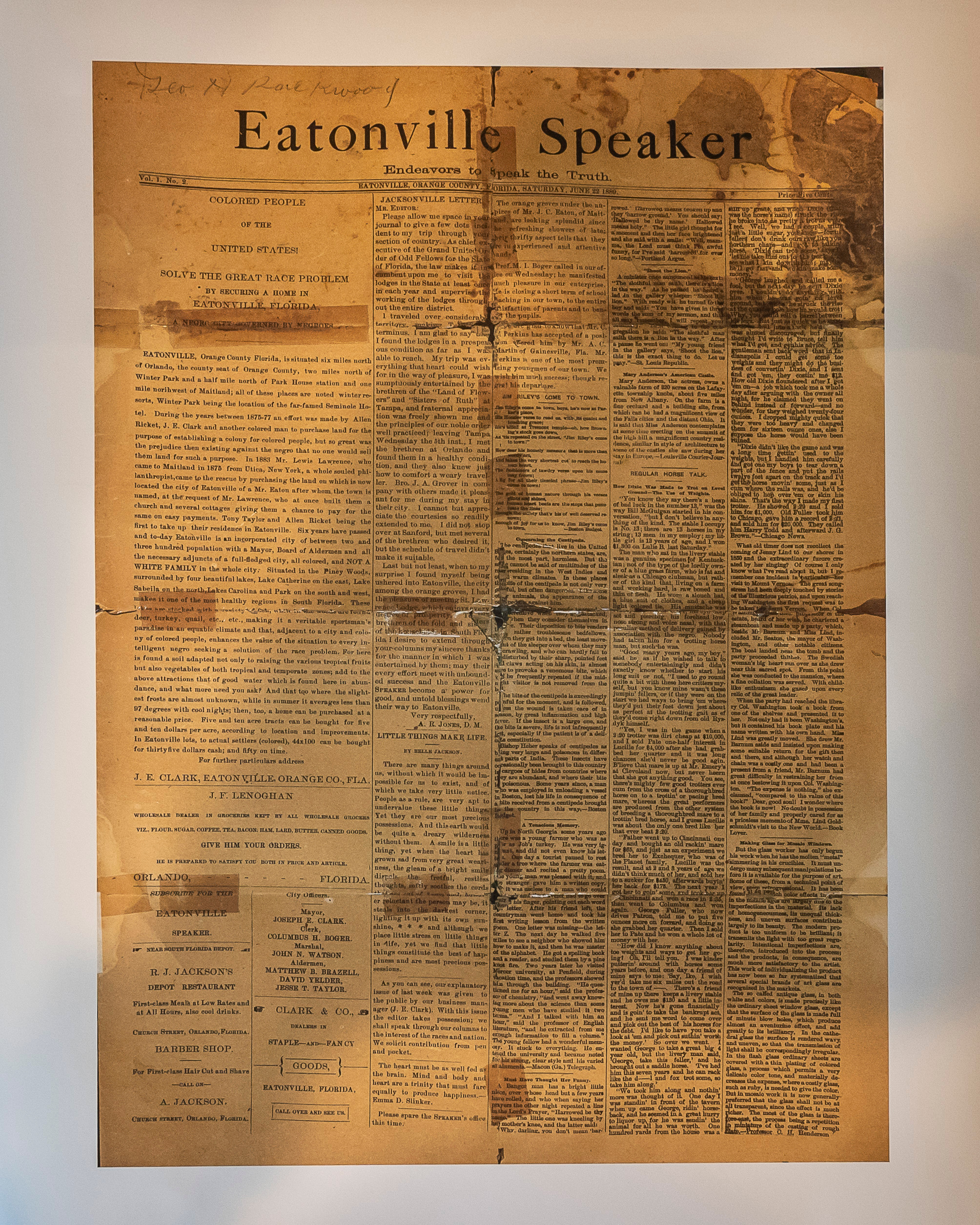National Trust for Historic Preservation names Eatonville an endangered site
Fueled by the urgent need to safeguard a threatened centerpiece of American history, the National Trust for Historic Preservation today named Eatonville, Florida – the childhood home of iconic author Zora Neale Hurston and one of the first all-Black municipalities in the U.S. – as one of 11 historic sites in the country most endangered and in need of protection.
The designation announced at a ceremony today in the community six miles north of Orlando is a major victory for the Association to Preserve the Eatonville Community (P.E.C.), a client of the Southern Poverty Law Center that has been developing its vision to convert land in the town that had been slated for redevelopment into a destination for tourism and study. The community group hopes the development of such a cultural and educational center will spark an economic renaissance centered on the town’s rich cultural, sociological and literary history.
The designation by the National Trust is a purely honorific title with no legal or regulatory restrictions attached. However, the visibility that comes from the listing by the nation’s preeminent private preservation organization can help encourage decision-makers to endorse stewardship, advocacy and restoration.
Since its first publication in 1988, the list has helped save hundreds of places intrinsically linked with the American story, including Angel Island Immigration Station in San Francisco Bay; civil rights landmark Little Rock Central High School in Arkansas; the soaring TWA terminal at New York’s JFK Airport, a triumph of Modernist architecture; Native American cultural landscapes like Bears Ears in Utah; and President Lincoln’s Cottage in Washington, D.C. While placement on the list itself does not provide legal protections, fewer than 5% of listed sites have been lost.
Citing the novel set in Eatonville that is considered Hurston’s masterpiece, Carol Quillen, CEO and president of the National Trust, said, “The backdrop to Their Eyes Were Watching God is a place that signifies Black autonomy and Black achievement in a country where we have not historically acknowledged the achievements of Black people.
“Historic sites are real. They are material evidence of our history and of our lives together as Americans,” Quillen said. “I believe that these sites hold out hope to those of us who wish to rebuild the public sphere, to account for the places where people who have been marginalized made history, and to reconstitute public debate on issues that matter to all of us.”
In addition to the designation, the African American Cultural Heritage Action Fund, a program of the National Trust, is awarding a $200,000 grant to the town of Eatonville to help fund the development of planning mechanisms by which local leaders hope to enhance and protect the town.
‘American as apple pie’
Eatonville is one of fewer than 200 Black settlements that became all-Black incorporated communities with autonomous Black city governments. Today, “The Town That Freedom Built,” as Eatonville is known, is one of the only such surviving communities. Officials with the Action Fund call the grant a first step in what they predict will be continued efforts to support the preservation of the town.
“The aspiration of the founding families of Eatonville is as American as apple pie,” said Melissa Jest, senior manager of the National Trust’s African American Cultural Heritage Action Fund. “Their desire to emerge from enslavement to take advantage of the Reconstruction era to build a community that was uniquely theirs, where they could continue to be free even in the face of Black codes, even in the face of Jim Crow, is an aspiration that all humans can tap into. This is a keen opportunity for the National Trust and the Action Fund to support their efforts to preserve and revitalize the tangible evidence of those aspirations.”
Founded in 1887 during Reconstruction, Eatonville was one of the first towns in the U.S. to be incorporated by people who were freed from slavery and was the childhood home of renowned Harlem Renaissance writer Hurston, who immortalized its thriving Black civic and cultural life in her most famous works.
In 1897, with help from Booker T. Washington and others, Black leaders established in Eatonville the Robert Hungerford Normal and Industrial School for the education of African American students. The school sat on 160 acres donated by the family of Robert Hungerford, a doctor who had brought medical care to young Black patients in Florida in the years after the Civil War.
The school became a mecca for young Black people who were otherwise afforded few, if any, educational opportunities due to their race. Hundreds of students from up and down the Eastern Seaboard took up residence on the sweeping campus of the illustrious school. Outside its gates, the town of Eatonville was for decades a destination for Black entertainers, intellectuals and entrepreneurs. Now in its 137th year of continuous Black leadership, Eatonville has a population that is 73% Black.
But today the modest, 1.6-square-mile patch of historic, mostly wood-frame houses and businesses sitting incongruously in the middle of the booming Orlando metropolitan area is surviving precariously. It has been staving off threats to its existence since the 1980s, when town activists beat back a highway-widening plan that would have cut five lanes of pavement right through the center of town.
Development threats
Over the past two years, first on its own and then in partnership with the SPLC, the P.E.C. has been fighting another existential threat – a proposal to build more than 300 residential housing units, along with extensive commercial, office and retail space, on the site of the former Hungerford School, a tract that makes up close to 15% of the town.
In February 2023, Eatonville residents won a key victory when the town council voted 4-1 against a rezoning plan that would have prepped the property for the development. A majority of the council had favored the development plan until public pressure swayed them.
The following month, the SPLC filed a suit on behalf of the P.E.C. against Orange County Public Schools, which owns the Hungerford property, over the planned sale of most of the tract to the developer. The same month, as the lawsuit and campaign aided by the SPLC elevated the threat into the national consciousness, the private developer seeking to build on the site backed off its plans, terminating the sales contract for the property.
The complaint was later amended to include an additional plaintiff, Bea Hatler, a direct descendant of Robert Hungerford, whose family donated the initial acreage for the establishment of the school. Hatler had been unaware of her family’s legacy until national news reports made their way to her last year. Ever since, she has joined forces with the people of Eatonville to safeguard the legacy they share. The litigation with the school board is ongoing.
“We see preservation of this historic site in American history as a way to drive economic development to this community that has been historically disinvested,” said Kirsten Anderson, deputy legal director for the SPLC’s Economic Justice litigation team. “The SPLC has brought all of its resources to ensure that economic development benefits the community instead of displaces it, and that Eatonville safeguards its history for future generations.”
Seeds sprouting
The recognition by the National Trust of the threats to Eatonville represents “a sea change” over the past two years in how Eatonville is viewed by people across the country, said N.Y. Nathiri, who as executive director of the P.E.C. has been making the argument for years that preservation and revitalization of the town’s rich history are the keys to bringing economic prosperity and vibrancy to the town.
Since 1990, the annual Zora Neale Hurston Festival of the Arts and Humanities (ZORA! Festival), which Nathiri’s organization created and which she helms, is held in Eatonville. The festival celebrates the study of Hurston and her literary legacy, the historic significance of her hometown, and the cultural contributions of people of African ancestry around the world.
The writer Alice Walker was a major contributor to the rediscovery and recognition of Hurston and of her roots in Eatonville. After she championed Hurston’s writing, Hurston’s books were reprinted and became part of the literary canon. Walker spoke at the first ZORA! Festival and was instrumental in getting Eatonville’s downtown district added to the federal government’s National Register of Historic Places in 1998. That designation does not include the Hungerford property.
The Zora Neale Hurston National Museum of Fine Arts, a small gallery in a building on Eatonville’s main street, is devoted to exhibiting the works of artists of African descent. It has only about 700 square feet of gallery space but has received state and federal funding, including from the National Endowment for the Arts and the SPLC.
Now those seeds long planted appear to finally be sprouting broader recognition for the historic town.
In addition to the recognition by the National Trust, Eatonville has secured funds under the Biden administration’s infrastructure plan to improve water and sewer systems. Without those systems, the plans envisioned by the P.E.C. cannot move forward. There is also talk of national funding to establish a historical archive in the town.
And last month, Eatonville was even named second among the top three finalists for the construction of a Florida Museum of Black History. The recommendations by a state task force established by Florida Gov. Ron DeSantis are being analyzed by Florida A&M University’s School of Architecture and Engineering Technology. The historically Black university’s findings will be presented at a May 21 meeting of the task force and will be used to inform its final recommendations in June.
“Up until two years ago it was like people outside had forgotten about Eatonville, and inside, people were, well, I would use the word despondent,” Nathiri said. “There was depression, frustration, they could see that things had been torn down, they were emotionally distraught.
“There is no doubt over the last two years that we can observe a quantifiable difference in the way that the mission of our organization, which is to preserve and bring economic prosperity to Eatonville, is resonating more and more. The SPLC has helped us make that possible. And now, to be recognized by the preeminent historic preservation organization in the country? It can’t get any better.”
Photo at top: In a photo from Oct. 25, 2023, Orange County Mayor Jerry Demings (center) and staff met with N.Y. Nathiri (just to the right of Demings in the photo), executive director of the Association to Preserve the Eatonville Community; Eatonville experts; and representatives of the SPLC and National Trust regarding the importance of historic preservation of Eatonville’s cultural assets. (Credit: Victor Watkins)
Read more about the effort to preserve Black history in Eatonville, Florida:
- Preserving Black Heritage: Florida activists fight to save historic site and their culture
- ‘Sacred Ground’: Effort to preserve historic Black Florida community wins key victory
- ‘Willing to Fight’: Residents rise up against development that could erase historic Florida town’s rich black heritage
- SPLC represents group suing over planned sale of the last 100 acres of property
- A timeline of events in Eatonville, Florida
- Developer of Black heritage site in Florida backs out of sales contract
- Descendant of land donor joins effort to preserve historic Florida community




